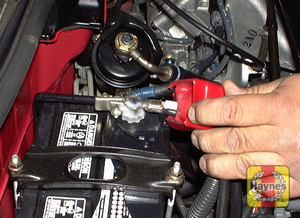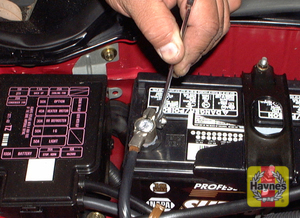Battery check Nissan Altima 1993 - 2006 | Haynes Manuals
You are here

Nissan Altima
1993 - 2006
Battery check
Time
5 to 15 minutes
Difficulty
1
A routine preventive maintenance program for the battery in your vehicle is the only way to ensure quick and reliable starts. But before performing any battery maintenance, make sure that you have the proper equipment necessary to work safely around the battery.
Tools and materials required for battery maintenance
1 Face shield/safety goggles - When removing corrosion with a brush, the acidic particles can easily fly up into your eyes
2 Baking soda - A solution of baking soda and water can be used to neutralize corrosion
3 Petroleum jelly - A layer of this on the battery posts will help prevent corrosion
4 Battery post/cable cleaner - This wire brush cleaning tool will remove all traces of corrosion from the battery posts and cable clamps
5 Treated felt washers - Placing one of these on each post, directly under the cable clamps, will help prevent corrosion
6 Puller - Sometimes the cable clamps are very difficult to pull off the posts, even after the nut/bolt has been completely loosened. This tool pulls the clamp straight up and off the post without damage
7 Battery post/cable cleaner - Here is another cleaning tool which is a slightly different version of Number 4 above, but it does the same thing
8 Rubber gloves - Another safety item to consider when servicing the battery; remember that’s acid inside the battery
2
There are also several precautions that should be taken whenever battery maintenance is performed. Before servicing the battery, always turn the engine and all accessories off and disconnect the cable from the negative terminal of the battery
3
The battery produces hydrogen gas, which is both flammable and explosive. Never create a spark, smoke or light a match around the battery. Always charge the battery in a ventilated area
4
Electrolyte contains poisonous and corrosive sulfuric acid. Do not allow it to get in your eyes, on your skin or on your clothes. Never ingest it. Wear protective safety glasses when working near the battery. Keep children away from the battery
5
Note the external condition of the battery. If the positive terminal and cable clamp on your vehicle’s battery is equipped with a rubber protector, make sure it isn’t torn or damaged. It should completely cover the terminal. Look for any corroded or loose connections, cracks in the case or cover or loose hold-down clamps. Also check the entire length of each cable for cracks and frayed conductors
6b Removing a cable from the battery post with a wrench - sometimes special battery pliers are required for this procedure if corrosion has caused deterioration of the nut hex (always remove the ground cable first and hook it up last)
7
Clean the cable clamps thoroughly with a battery brush or a terminal cleaner and a solution of warm water and baking soda. When cleaning the cable clamps, all corrosion must be removed (the inside of the clamp is tapered to match the taper on the post, so don’t remove too much material)
7a Regardless of the type of tool used to clean the battery posts, a clean, shiny surface should be the result
8
Make sure the battery tray is in good condition and the hold-down clamp bolt or nut is tight. If the battery is removed from the tray, make sure no parts remain in the bottom of the tray when the battery is reinstalled. When reinstalling the hold-down clamp bolt or nut, do not over-tighten it
Note:
Lift out the battery. Special battery lifting straps that attach to the battery posts are available at auto parts stores, lifting and moving the battery is much easier if you use one
Cleaning
9
Corrosion on the hold-down components, battery case and surrounding areas can be removed with a solution of water and baking soda. Thoroughly rinse all cleaned areas with plain water
10
Any metal parts of the vehicle damaged by corrosion should be covered with a zinc-based primer, then painted
Charging
Warning:
When batteries are being charged, hydrogen gas, which is very explosive and flammable, is produced. Do not smoke or allow open flames near a charging or a recently charged battery. Wear eye protection when near the battery during charging. Also, make sure the charger is unplugged before connecting or disconnecting the battery from the charger
11
Slow-rate charging is the best way to restore a battery that’s discharged to the point where it will not start the engine. It’s also a good way to maintain the battery charge in a vehicle that’s only driven a few miles between starts. Maintaining the battery charge is particularly important in the winter when the battery must work harder to start the engine and electrical accessories that drain the battery are in greater use
12
It’s best to use a one or two-amp battery charger (sometimes called a “trickle” charger). They are the safest and put the least strain on the battery. They are also the least expensive. For a faster charge, you can use a higher amperage charger, but don’t use one rated more than 1/10th the amp/hour rating of the battery. Rapid boost charges that claim to restore the power of the battery in one to two hours are hardest on the battery and can damage batteries not in good condition. This type of charging should only be used in emergency situations
13
The average time necessary to charge a battery should be listed in the instructions that come with the charger. As a general rule, a trickle charger will charge a battery in 12 to 16 hours




